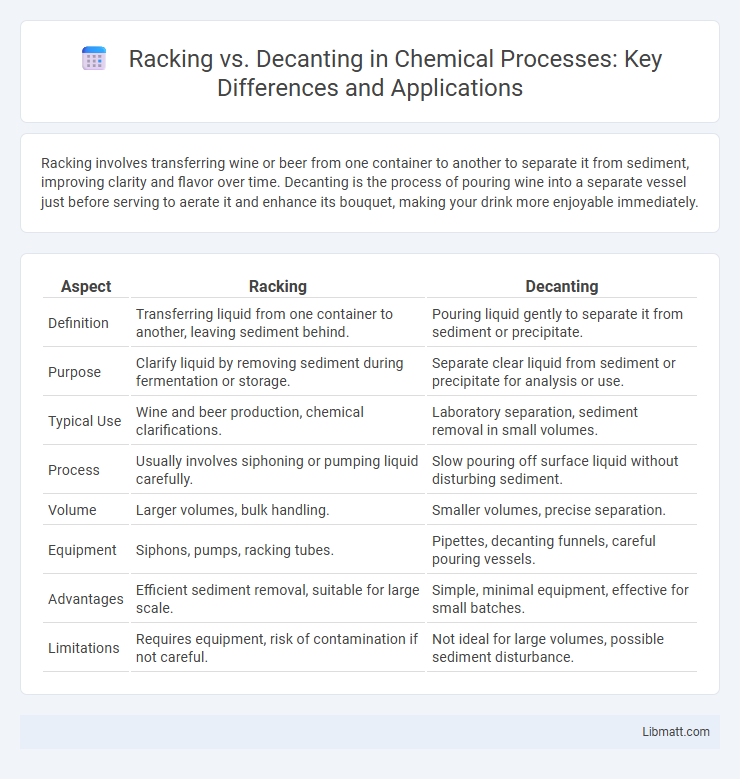Racking involves transferring wine or beer from one container to another to separate it from sediment, improving clarity and flavor over time. Decanting is the process of pouring wine into a separate vessel just before serving to aerate it and enhance its bouquet, making your drink more enjoyable immediately.
Table of Comparison
| Aspect | Racking | Decanting |
|---|---|---|
| Definition | Transferring liquid from one container to another, leaving sediment behind. | Pouring liquid gently to separate it from sediment or precipitate. |
| Purpose | Clarify liquid by removing sediment during fermentation or storage. | Separate clear liquid from sediment or precipitate for analysis or use. |
| Typical Use | Wine and beer production, chemical clarifications. | Laboratory separation, sediment removal in small volumes. |
| Process | Usually involves siphoning or pumping liquid carefully. | Slow pouring off surface liquid without disturbing sediment. |
| Volume | Larger volumes, bulk handling. | Smaller volumes, precise separation. |
| Equipment | Siphons, pumps, racking tubes. | Pipettes, decanting funnels, careful pouring vessels. |
| Advantages | Efficient sediment removal, suitable for large scale. | Simple, minimal equipment, effective for small batches. |
| Limitations | Requires equipment, risk of contamination if not careful. | Not ideal for large volumes, possible sediment disturbance. |
Understanding Racking and Decanting
Racking involves transferring wine from one container to another, typically to separate it from sediment and clarify the liquid, a key process in winemaking and aging. Decanting refers to pouring wine from its bottle into a decanter, primarily to aerate the wine and enhance its flavors while also leaving sediment behind. Both techniques improve wine quality but serve distinct purposes: racking targets sediment removal during production, while decanting optimizes presentation and taste before serving.
Key Differences Between Racking and Decanting
Racking is the process of transferring wine or beer from one container to another to separate it from sediment, while decanting involves pouring wine into a vessel to aerate it and enhance flavor before serving. Racking is primarily a clarification and stabilization technique used during fermentation or aging, whereas decanting is intended for immediate consumption to improve taste and presentation. The equipment differs as racking uses siphons or pumps, whereas decanting requires a decanter or similar vessel designed for aeration.
The Purpose of Racking in Winemaking
Racking in winemaking serves the crucial purpose of separating wine from sediment and lees that accumulate during fermentation and aging, enhancing clarity and stability. This process helps prevent off-flavors and unwanted microbial growth by removing dead yeast cells and other particulate matter. Racking also promotes oxygen exposure in a controlled manner, improving the wine's development and overall quality.
How Decanting Enhances Wine Experience
Decanting enhances the wine experience by allowing the wine to aerate, which releases complex aromas and softens tannins for a smoother taste. Unlike racking, which primarily separates wine from sediment during aging, decanting is designed to improve immediate flavor and bouquet, especially in older or full-bodied wines. This process maximizes the sensory enjoyment by unveiling subtle notes often hidden in the bottle.
When to Choose Racking Over Decanting
Choose racking over decanting during the winemaking process when clarification is needed without disturbing sediment, as racking gently transfers wine from one vessel to another, leaving lees behind. It is especially suitable after fermentation or aging stages to improve wine stability and purity. Opt for racking to reduce the risk of oxygen exposure compared to decanting, preserving delicate aromas and flavors.
Techniques for Effective Racking
Techniques for effective racking involve carefully siphoning wine from sediment without disturbing the lees, preserving clarity and flavor. Using a clean, food-grade siphon tube and positioning it above the sediment layer ensures minimal oxidation and contamination during transfer. Your careful attention to timing and cleanliness directly impacts the quality of the final wine.
Step-by-Step Guide to Decanting Wine
Decanting wine involves carefully pouring it from the bottle into a decanter to separate sediment and enhance aeration. Start by standing the bottle upright for several hours to allow sediment to settle, then gently pour the wine slowly into the decanter without disturbing the sediment at the bottom. This process improves your wine's flavor and aroma by allowing it to breathe and releasing volatile compounds.
Impact on Wine Flavor and Clarity
Racking gently separates wine from sediment, enhancing clarity without disrupting delicate flavor compounds, while decanting exposes wine to oxygen, intensifying aromas and softening tannins for a more expressive taste. Your choice between racking and decanting directly influences the balance of flavor development and visual purity in each glass. Proper application of these techniques ensures optimal wine presentation and enjoyment.
Common Mistakes in Racking and Decanting
Common mistakes in racking include disturbing sediment, which can introduce off-flavors and cloudiness, and failing to sanitize equipment properly, leading to contamination. When decanting, improper timing or rushing the process may cause premature oxidation or lose aromas, while neglecting to pour carefully risks agitating sediment. By understanding these pitfalls, you can protect your wine's clarity and flavor, ensuring your next bottle pours perfectly.
Expert Tips for Better Wine Preservation
Racking wine involves carefully transferring it off the sediment to clarify and improve flavor, while decanting primarily aerates the wine for immediate consumption, enhancing aroma and taste. Experts recommend racking during fermentation and aging to prevent off-flavors caused by sediment decomposition, whereas decanting is best performed just before serving to showcase the wine's bouquet. Proper timing and technique in both racking and decanting preserve wine quality, ensuring optimal taste and longevity.
racking vs decanting Infographic

 libmatt.com
libmatt.com